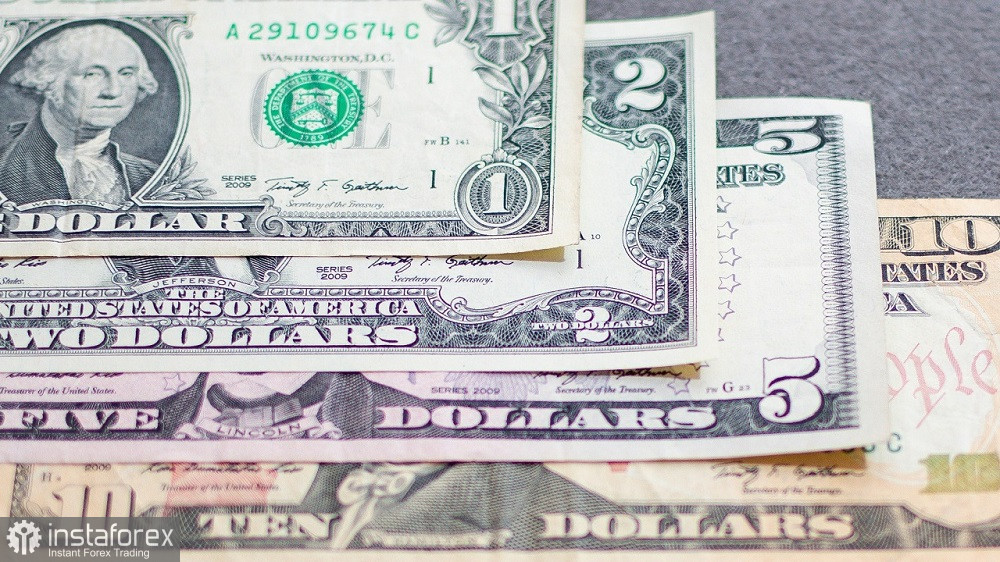The EUR/USD pair has surged once again, towards the 1.10 level, after previously falling to the 1.0930 level. The bearish pullback was due to the release of data on the Producer Price Index in Germany. This inflation indicator decreased by 0.5% on a monthly basis (compared to an expected decrease of 0.3%), and on an annual basis, it dropped to -7.9% (compared to an expected decline to -7.3%). Both components of the report came out in the "red," disappointing the bulls. However, the corrective pullback was limited and had a more formal nature.
If we look at the weekly chart, we can see that the pair is still within an uptrend, but the bullish momentum came to a halt. Bears are trying to take the initiative, but the corrective declines look quite modest (a few tens of pips), afterwards the bears, "just in case," took profit, allowing the pair to stay within the 1.09 level.

The immediate reason for Thursday's bullish surge was the U.S. GDP data. Real GDP grew at an annual rate of 4.9% in the third quarter of 2023, according to the Bureau of Economic Analysis, while the "second" estimate of the indicator indicated an increase in the economy by 5.2%. The GDP price index was revised lower to 3.3% (the initial estimate was 3.6%).
In general, the pair increased not only because the dollar weakened (amid the market's dovish expectations regarding the Federal Reserve's future course of actions) but also due to the euro's strength. The European Central Bank continues to support the single currency by making quite hawkish statements. However, in this case, the "hawkishness" is expressed in the ECB's commitment to keeping rates at their current level for an extended period, at least throughout the first half of 2024.
Several representatives of the ECB, including Bundesbank President Joachim Nagel and Bank of Greece Governor Yannis Stournaras, have warned market participants against speculating about an imminent rate cut. In particular, Nagel reiterated the thesis that rates will remain at the current plateau in the foreseeable future so that monetary policy can fully develop its impact in restraining inflation.
In the current fundamental conditions, maintaining the status quo is a hawkish factor because the Fed is preparing to lower interest rates in the early part of 2024. To be more precise, market participants arrived at such conclusions after Fed members voiced dovish intentions at the December meeting. The Fed did not set any specific timeframe—market participants drew their own conclusions. According to the CME FedWatch Tool, markets are pricing in a 70% probability that the Fed will cut the interest rate by 25 basis points at the March meeting. Moreover, the probability of a rate cut to 5.0% at the next meeting in May is at 72%. It's worth mentioning the updated dot plot, indicating that most Fed members expect a 75-basis-point cut in the policy rate in 2024.
To be fair, some Fed members, including Austin Goolsbee, are trying to sober up market participants by stating that the timing and scale of monetary easing have not been determined. However, these efforts are in vain, as the momentum of dovish expectations continues to build. This theme has taken on a life of its own. If the core PCE price index, scheduled for release on Friday (December 22), meets or exceeds the forecast (not to mention entering the "red zone"), market dovish expectations will intensify again. The dollar will face additional pressure, and the bulls will try to consolidate around the 1.10 level.
In other words, the uptrend has not ended; it is merely on pause. The key report of this week, to lift the situation from this pause, is anticipated to be released at the start of the U.S. session on Friday. According to preliminary forecasts, the core Personal Consumption Expenditures (PCE) index on a year-on-year basis is expected to decrease to its lowest level since May 2021. Recall that after rising to 4.3% in July, this indicator sharply declined to 3.8% in August, followed by further declines in September (to 3.7%) and October (3.5%). According to most experts, the indicator is expected to decrease again in November, this time to 3.4%.
In summary, a few conclusions can be drawn. Firstly, it is still advisable not to trust bearish pullbacks; the dollar is currently unable to turn the situation in its favor, and the euro is benefiting from indirect support from the European Central Bank. Secondly, the pair still has the potential to rise. Traders are clearly gravitating towards the 1.10 level, but it needs a strong informational catalyst to breach this barrier. Hence, the third conclusion is that the fate of the uptrend largely depends on the core PCE index, the November value of which will be revealed on Friday.
 English
English 
 Русский
Русский Bahasa Indonesia
Bahasa Indonesia Bahasa Malay
Bahasa Malay ไทย
ไทย Español
Español Deutsch
Deutsch Български
Български Français
Français Tiếng Việt
Tiếng Việt 中文
中文 বাংলা
বাংলা हिन्दी
हिन्दी Čeština
Čeština Українська
Українська Română
Română

